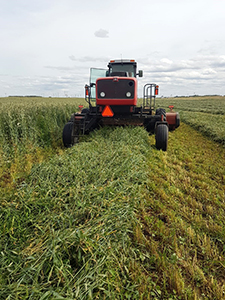
Mixtures of Peas and Cereals for Greenfeed
By Jenifer Heyden, M.Sc., PAg, Livestock and Feed Extension Specialist, North Battleford Regional Office
Cereal greenfeed is a viable winter feed source for beef producers across the prairies. Depending on harvest parameters, it can be a nutrient dense feed with adequate protein and ample energy to maintain the herd, at least through mid-pregnancy.
However, for mature cows in late gestation or lactation stages, or for growing replacement heifers, crude protein is often too low in cereal greenfeed and too high in pea greenfeed. Thus, the inclusion of peas into cereal greenfeed has the potential to provide an adequate amount of protein under most production circumstances. Typically, cereal greenfeed is about eight to 10 per cent protein and pea forage around 13-18 per cent protein. Theoretically, a pea-cereal mix should have higher protein than a pure cereal and lower protein than pure pea forage. Previous research has shown that when peas are included in the mixture at 50 per cent or more of the sown mixture (by weight), crude protein in the harvested forage is two to four percentage points higher than with pure cereals. In addition, neutral detergent fibre levels have been shown to be two to 4.5 percentage points lower in mixtures that included peas, resulting in a higher feed intake potential.
Mixing field peas with a cereal grain for forage has become more common. The primary benefit of peas mixed with cereals is to improve quality with a possible boost in yield. The University of Saskatchewan tested the effects of including forage pea in mixtures with forage oat and barley on overall greenfeed yield, nutrient density, palatability, dry matter intake and nutrient digestibility. Data was gathered in 2016-17 from sites across Saskatchewan, including Saskatoon, Melfort and Swift Current.

Barley, oats and peas were seeded in monocultures and in mixtures with seeding rates of pea:cereal of 100:30 and 50:50, with nitrogen (N) fertilizer application rates of either 60 kg N/ha or no N applied. Barley and pea-barley plots were harvested when barley was at the hard dough stage, while oat and pea-oat plots were harvested when oats reached the soft dough stage. Pea seeded as a monoculture was harvested at early, mid and late maturity. It is important to note that the composition of the “mature” greenfeed crop differed from the seeded crop; the ratio of pea to cereal in the forage mix was lower than the initial seeding rate ratio. The pea:barley seeding rate ratio of 50:50 and 100:30 resulted in 12 per cent and 29 per cent pea proportion in the harvested pea-barley mixtures, while pea:oat seeding rate ratios of 50:50 and 100:30 had a pea proportion of 10 per cent and 23 per cent in pea-oat mixtures at harvest. Fertilizer application had no bearing on the composition of peas in the mature mixtures.
The application of nitrogen fertilizer resulted in higher costs, but also higher economic return. The pea-barley mixtures and barley monocrop had the highest rate of economic return at all project locations. The application of fertilizer also resulted in increased crude protein and yield, mixtures containing peas had the highest levels of crude protein and that level increased as the ratio of pea increased. Pea-cereal mixtures had a yield advantage and less lodging compared to the monocrops.
As expected, the crude protein (CP) content of the pea monocrop was higher than required, whereas the CP content of the oat and barley monocrops were too low. The pea-cereal mixtures had an adequate amount of CP to sustain both mid-and-late pregnancy beef cows and replacement beef heifers. However, lactating cows would require an additional protein supplement to meet their requirements when they have a calf at side. As cereal crops mature, neutral detergent fibre, (NDF), the fibre that limits physical intake, increases and dry matter consumption can be reduced. In this study, NDF was lower in pea-cereal mixtures versus the monocrops, removing any potential physical limitations and resulting in an increase in dry matter intake.
So, what does all this mean? Including peas into your cereal greenfeed has many advantages, including improvements in yield, crude protein and dry matter intake. These improvements present great opportunities for beef cattle producers, providing them the ability to reduce the need for some grain or supplements in winter rations by feeding the better quality forage created by intercropping pea with cereals for greenfeed.
For the latest information and for more updates on everything Kindersley ‘Like’ the Kindersley Social Facebook page below…








































